Configuration File
The configuration file contains a set of settings that are required by the Integration Framework to properly connect to the right database.
The configuration file is created when the Integration Framework plugin is loaded for the first time, or updated if any fields are missing. Some default properties should be changed for the Integration Framework to work properly.
The default location of the configuration file is at C:\ProgramData\LS Retail\LS One Site Service\IntegrationFrameworkPlugins.config.
Configuration fields
| Name | Description |
|---|---|
| LogLevel |
Set which event types will be logged. Valid values are:
|
| ExternalAddress | The external address of the database server. If left blank, the server is considered to be the local computer. |
| DatabaseServer | The name of the database server. |
| DatabaseWindowsAuthentication | True if the connection to the database should use windows authentication. |
| DatabaseUser | The user name of the database user. |
| DatabasePassword | The password of the database user. |
| DatabaseName | The name of the database. |
| PrivateHashKey | A key used to validate the admin authentication for the connection pool. |
| MaxCount | The maximum connections that the connection pool can hold. |
| MaxUserConnectionCount | The maximum user connections per connection in the connection pool. |
| DatabaseConnectionType | The connection type used for connecting to the database. Valid values are "Named pipes" and "TCP/IP". Any other values will default to "Shared memory". |
| SiteManagerUser | The user name of the Site Manager user used for connecting to the database. A special server user has to be created in Site Manager. |
| SiteManagerPassword | The password of the Site Manager user. |
| DataAreaID | The data area ID. |
| Port | The port on which the Integration Framework service should work on. |
| EMailSendInterval | Time interval in minutes, in which to send periodic emails. |
| EMailMaximumBatch | The maximum number of email that can be sent in a single batch. |
| EMailMaximumAttempts | The maximum number of retries, if sending emails fails. |
| EMailTruncateQueue |
Set how should emails be deleted from the queue after sending a batch. Valid values are:
|
| IsCloud | True if the service is a cloud installation. |
| EnableServiceDiscovery |
True if the Integration Framework services should be discoverable. Default value: false |
| EnableHttpEndpoint |
True if the Integration Framework services should also be available over http/https. Default value: false |
| HttpPort |
The port on which the Integration Framework services should work on http/https. Default value: 9103 |
| EnforceHttps |
True if the Integration Framework services should work only on https.

In PRODUCTION environments it should always set to true, so that the Integration Framework services will not be available over plain-text http. Default value: false |
| SslCertificateThumbnail | SSL certificate thumbnail used by Integration Framework services when running on https. |
| SslStoreLocation |
SSL certificate store location. Valid values are:
Default value: LocalMachine. |
| SslStoreName |
SSL certificate store name. Valid values are:
Default value: My. |
| IFUser | A valid LSOne user used by Integration Framework services to access the LSOne system. |
| IFPassword | The password of the LSOne user used by Integration Framework servies. |
| IFStoreID | A valid LSOne store used by Integration Framework services to access the LSOne system. |

Some of the fields, like the email settings, are not used by the Integration Framework, but they can be configured in the same way in the site service configuration file.
Configuration file example
Below you can see the default configuration file. The most important fields are marked with a red dot.


